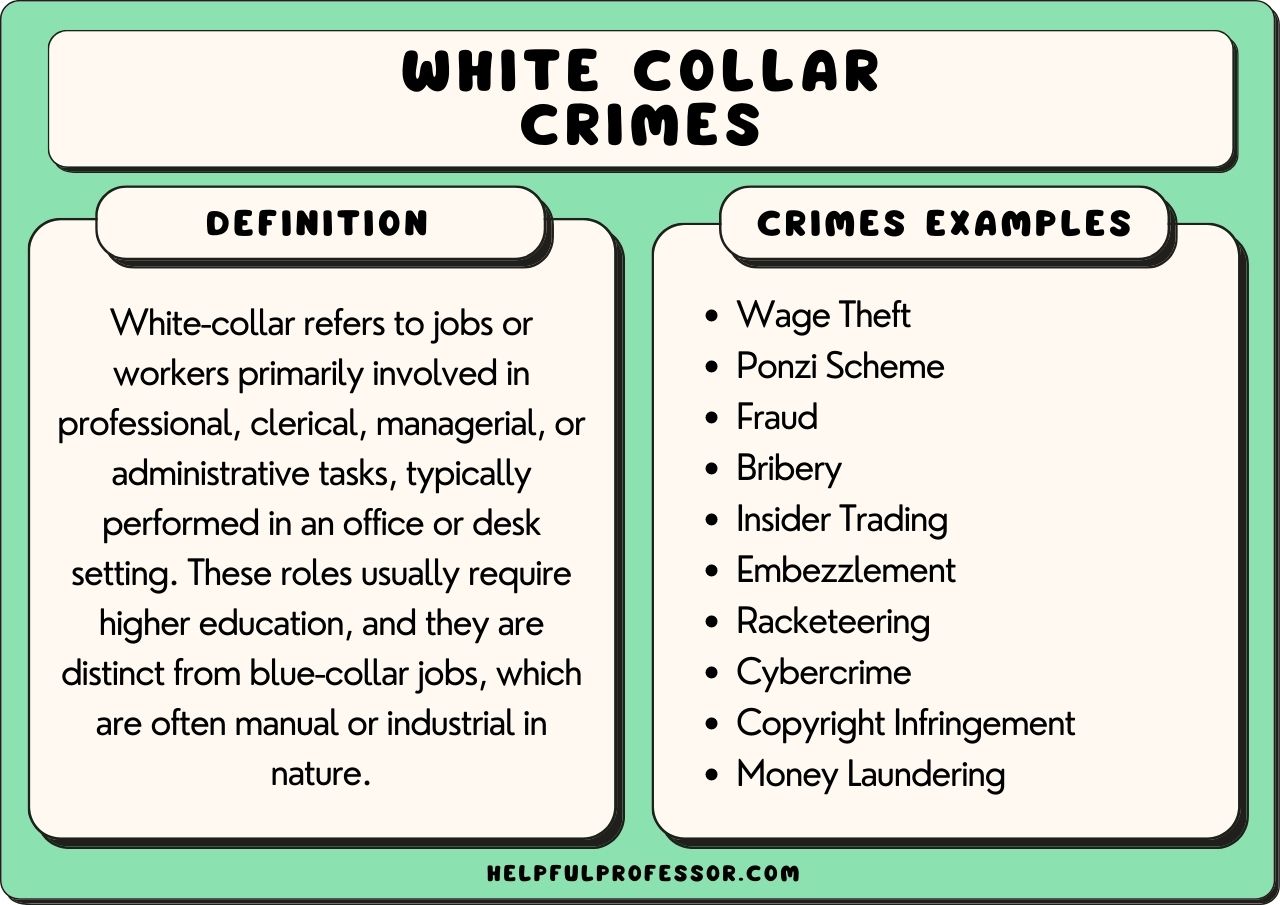What is the difference between street crime and white-collar crime – When discussing the topic of crime, it’s crucial to differentiate between street crime and white-collar crime. While both are illegal activities, they differ significantly in nature, methods, and consequences. This comprehensive analysis will delve into the key distinctions between these two types of crime, providing a deeper understanding of their impact on society.
Street crime, often associated with violence and physical harm, typically involves offenses such as robbery, assault, and drug dealing. White-collar crime, on the other hand, encompasses non-violent offenses committed by individuals in positions of trust, such as fraud, embezzlement, and insider trading.
Definition and Nature
Street crime and white-collar crime are two distinct categories of criminal activity with different characteristics and societal impacts.Street crime typically involves offenses that are committed in public spaces, often involving violence or the threat of violence. Examples include robbery, assault, and drug dealing.
These crimes are often perpetrated by individuals who have limited economic resources and may be motivated by factors such as poverty, unemployment, or addiction.White-collar crime, on the other hand, refers to nonviolent offenses that are committed in the course of business or professional activities.
These crimes often involve fraud, embezzlement, or insider trading. White-collar criminals are typically motivated by financial gain or the desire for power and status.Despite their differences, street crime and white-collar crime share some commonalities. Both types of crime can have devastating consequences for victims, both financial and emotional.
Additionally, both types of crime can contribute to social unrest and a sense of insecurity within communities.
Methods and Targets

Street crimes and white-collar crimes employ distinct methods and target different victims. Street crimes are often characterized by direct, physical confrontations, while white-collar crimes involve more indirect, non-violent tactics.
Street crimes typically involve theft, assault, and drug offenses. They are often committed in public places, such as streets, parks, and parking lots. The methods used to commit street crimes can vary depending on the specific crime. For example, theft may involve pickpocketing, shoplifting, or carjacking.
Assault may involve physical violence, such as punching, kicking, or using a weapon. Drug offenses may involve the possession, sale, or distribution of illegal drugs.
White-collar crimes, on the other hand, are typically non-violent and involve fraud, embezzlement, and other financial crimes. They are often committed in the workplace or in the context of business transactions. The methods used to commit white-collar crimes can be complex and may involve the use of sophisticated financial instruments or computer systems.
For example, fraud may involve creating fake invoices or falsifying financial records. Embezzlement may involve stealing money or property from an employer or client. Insider trading may involve using non-public information to make profitable trades in the stock market.
The targets of street crime and white-collar crime also differ. Street crimes often target individuals, such as pedestrians, shoppers, and motorists. White-collar crimes, on the other hand, often target businesses, organizations, and government agencies. This is because white-collar crimes typically involve large sums of money or other valuable assets.
Targets of Street Crime
- Individuals
- Pedestrians
- Shoppers
- Motorists
Targets of White-Collar Crime
- Businesses
- Organizations
- Government agencies
Impact and Consequences
Street crime and white-collar crime have vastly different impacts on society and individuals. Both types of crimes can lead to significant financial losses, but white-collar crimes often involve larger sums of money and more widespread consequences.
Social Impact, What is the difference between street crime and white-collar crime
Street crime can create a sense of fear and insecurity within communities, especially when it involves violent acts. White-collar crimes, on the other hand, can erode trust in institutions and the economy, as they often involve deception and manipulation by those in positions of power.
Economic Impact
Street crime can result in direct financial losses for victims, such as stolen property or medical expenses. White-collar crimes, however, can have far-reaching economic consequences, such as market instability, job losses, and reduced consumer confidence.
Consequences for Individuals
The consequences faced by individuals convicted of street crimes and white-collar crimes vary significantly. Street crimes often carry harsher sentences, including imprisonment, due to their immediate and visible impact on victims. White-collar crimes, on the other hand, may result in fines or probation, as they are often viewed as less harmful and involve complex legal proceedings.
Challenges in Investigation and Prosecution
Investigating and prosecuting white-collar crimes can be challenging due to their often intricate nature and the involvement of sophisticated financial transactions. These crimes may require specialized knowledge and expertise to uncover and prove, which can make it difficult to hold perpetrators accountable.
Prevention and Control: What Is The Difference Between Street Crime And White-collar Crime
Preventing and controlling street crime and white-collar crime requires a multifaceted approach involving law enforcement, community organizations, and individuals. By implementing effective strategies, we can reduce the incidence of these crimes and create safer communities.
Law Enforcement
Law enforcement plays a crucial role in preventing and controlling crime. They can implement strategies such as:
- Increased patrols in high-crime areas
- Targeted investigations of known offenders
- Community policing initiatives to build relationships with residents
Community Organizations
Community organizations can also contribute to crime prevention through:
- Neighborhood watch programs
- After-school programs for youth
- Job training and educational opportunities for at-risk individuals
Individuals
Individuals can also take steps to prevent crime, such as:
- Being aware of their surroundings
- Reporting suspicious activity to the authorities
- Participating in community safety initiatives
Ethical and Societal Implications

Street crime and white-collar crime have profound ethical and societal implications that extend beyond their immediate victims. Both types of crimes erode public trust and damage social cohesion.
Impact on Public Trust
Street crimes, such as muggings and burglaries, create a sense of fear and insecurity among citizens. They undermine trust in law enforcement and the justice system, as people may feel that their safety and property are not adequately protected. White-collar crimes, such as corporate fraud and financial scams, can also shatter public trust.
These crimes demonstrate that even those in positions of power and responsibility are not above breaking the law, leading to a sense of disillusionment and cynicism.
Impact on Social Cohesion
Street crime can create divisions within communities, as victims may feel isolated and distrustful of others. It can also lead to social unrest and vigilante justice, as people take matters into their own hands in response to perceived inaction by authorities.
White-collar crimes can also damage social cohesion by exacerbating economic inequality and eroding trust in institutions.
Role of Media
The media plays a significant role in shaping public perceptions of street crime and white-collar crime. Sensationalized reporting of street crimes can create a distorted view of their prevalence and severity, leading to fear and mistrust. On the other hand, white-collar crimes often receive less media attention, which can contribute to a perception that these crimes are less serious or that perpetrators are above the law.
Ultimate Conclusion
In conclusion, street crime and white-collar crime represent distinct categories of illegal activities with varying characteristics, methods, and consequences. Understanding these differences is essential for effective crime prevention, law enforcement, and social policy. By addressing both types of crime with appropriate strategies, we can strive to create a safer and more just society.
Quick FAQs
What are the common characteristics of street crime and white-collar crime?
Both street crime and white-collar crime involve violations of the law and can have negative consequences for individuals and society.
How do the methods used to commit street crime differ from those used in white-collar crime?
Street crime often involves physical force or violence, while white-collar crime typically involves deception, manipulation, or abuse of trust.
What are the key challenges in investigating and prosecuting white-collar crimes?
White-collar crimes can be complex and difficult to detect due to their non-violent nature and the involvement of sophisticated financial transactions.


